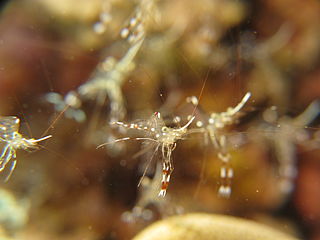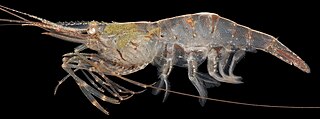
The Caridea, commonly known as caridean shrimp or true shrimp, from the Greek word καρίς, καρίδος, are an infraorder of shrimp within the order Decapoda. This infraorder contains all species of true shrimp. They are found widely around the world in both fresh and salt water. Many other animals with similar names – such as the mud shrimp of Axiidea and the boxer shrimp of Stenopodidea – are not true shrimp, but many have evolved features similar to true shrimp.

A freshwater prawn farm is an aquaculture business designed to raise and produce freshwater prawns or shrimp for human consumption. Freshwater prawn farming shares many characteristics with, and many of the same problems as, marine shrimp farming. Unique problems are introduced by the developmental life cycle of the main species.

Macrobrachium rosenbergii, also known as the giant river prawn or giant freshwater prawn, is a commercially important species of palaemonid freshwater prawn. It is found throughout the tropical and subtropical areas of the Indo-Pacific region, from India to Southeast Asia and Northern Australia. The giant freshwater prawn has also been introduced to parts of Africa, Thailand, China, Japan, New Zealand, the Americas, and the Caribbean. It is one of the biggest freshwater prawns in the world, and is widely cultivated in several countries for food. While M. rosenbergii is considered a freshwater species, the larval stage of the animal depends on brackish water. Once the individual shrimp has grown beyond the planktonic stage and becomes a juvenile, it lives entirely in fresh water.
Cryphiops caementarius is a South American freshwater shrimp.
Macrobrachium agwi is a species of freshwater shrimp, first described in 2008, endemic to the Himalaya. It was discovered when a shipment of ornamental prawns, destined for the aquarium trade, was shipped from Cooch Behar, West Bengal, India to Europe. Examination of the shipment showed that one type of shrimp was a new, undescribed species.

Macrobrachium ohione, commonly known as the Ohio shrimp, Ohio river shrimp or Ohio river prawn, is a species of freshwater shrimp found in rivers throughout the Gulf of Mexico and Atlantic Ocean drainage basins of North America. It is the best-known of all North American freshwater shrimp, and is commonly used as bait for commercial fishing, especially catfish.

Macrobrachium is a genus of freshwater prawns or shrimps characterised by the extreme enlargement of the second pair of pereiopods, at least in the male.

Urocaridella antonbruunii, common names clear cleaner shrimp or red-white cleaner shrimp, is a species of shrimp belonging to the family Palaemonidae. It was described by A. J. Bruce in 1967. It is one of the species that are known as cleaner shrimps.

Palaemon adspersus, commonly called Baltic prawn, is a species of shrimp that is frequent in the Baltic Sea, and is the subject of fisheries in Denmark. It is up to 70 mm (2.8 in) long, and lives in Zostera beds.
Macrobrachium crenulatum is an amphidromous freshwater shrimp of the Palaemonidae family in the Decapoda order. It is found in lowland rivers and streams from Panama to Venezuela, as well as on several Caribbean islands. The species is common in the Toro Negro State Forest in central Puerto Rico. Studies have shown that the species have higher sensitivity to environmental, hydrological and chemical factors than other crustaceans also studied and which affect its migratory patterns.
Macrobrachium vollenhoveni, the African river prawn, is a species of large, commercially important prawn from the family Palaemonidae from West Africa. It is a catadromous species that moves from freshwater to brackish water to spawn returning to freshwater as larvae. Recent research has shown that it could potentially be used as a biological control to reduce the rates of infection people living near rivers where this species occurs with schistosomiasis.

Palaemon macrodactylus is a species of shrimp of the family Palaemonidae.

Macrobrachium nobilii is a species of freshwater shrimp, first described by Henderson and Matthai, 1910. It belongs to the order Decapoda and family Palaemonidae.
Macrobrachium zariquieyi is a freshwater prawn belonging to the genus Macrobrachium and the family Palaemonidae. It is found in West Africa and reported in Côte d'Ivoire river. The species name of this species is dedicated to Ricardo Zariquiey who worked on Spanish decapods.
Macrobrachium scabriculum is a species of freshwater shrimp. It is distributed in countries and territories around the Indian Ocean. It is known as Goda River prawn. The total length of male prawns become about 6.5 cm long and in females it is about 5 cm. A kind of fur develop on the chelipeds of males. Eggs produced by M. scabriculum are smaller in size, brownish in color, elliptical or oval in shape and hatched larvae undergone migration to low saline water for completion its life cycle.
Macrobrachium srilankense is a species of freshwater prawn belong the family Palaemonidae. The species was first described by Costa in the year 1979. It is reported from Sri Lanka.
Macrobrachium indicum is a species of freshwater shrimp of South India. It was first described in 1986. This freshwater prawn was described from Vellayani Lake, Kerala. This species is closely related to M. australe and M. ustulatum. It is a medium-sized prawn of genus Macrobrachium.
Macrobrachium veliense is a species of freshwater prawn belong the family Palaemonidae.
Macrobrachium banjarae is a species of freshwater shrimp that was first described in 1958. Macrobrachium banjarae belongs to the family Palaemonidae. It is an endemic prawn found India, in the states of Andhra Pradesh, Karnataka, Madhya Pradesh, Maharashtra and West Bengal.
Macrobrachium walvanense is a species of freshwater shrimp. It was first described in 1999 by Almelkar and coworkers. M. walvanense is collected from the Walvan Dam at Lonavala, near Pune. It is a medium-sized freshwater prawn grows a maximum size of 50 mm. Body is translucent with branched reddish-brown chromatophores spread from carpus to fingertips of second chelipeds. The features of rostrum, second cheliped, and telson are made it differs from M. banjarae.







